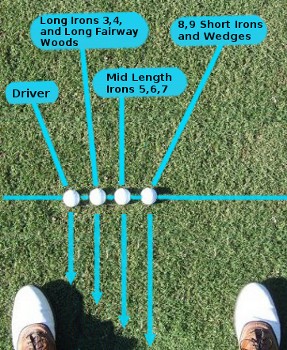
You are going to want to use the same ball position for most of your shots with any given club. For example, once you settle on a ball position to use with your driver, you will want to stick with it time after time. However, there are exceptions where you will want to alter your ball position a bit in order to achieve a specific result. In this last article, we are going to talk about some examples of those kinds of adjustments and techniques.
One potential adjustment is a fairly obvious one, and one which should be familiar to most experienced golfers. When you have a bad lie and need to play an iron shot, you will want to move the ball back in your stance. This is going to create a steeper swing plane, helping you to miss whatever is waiting behind the ball on the way toward impact. Of course, moving the ball back is going to change the dynamics of your swing to some degree, so you shouldn’t plan on hitting the same shot as you would hit with your normal ball position. Most likely, the shot is going to come out low, and it may tend to draw more than your typical iron shot (although that is not necessarily the case when hitting out of the rough). Bad lies are commonplace in this game, so you should be comfortable with making this type of adjustment.
Another way you can use a change in ball position to help expand your game can be seen on the tee. When hitting a drive that you want to curve in a direction that goes against your standard flight, you may be able to achieve such a shot with a simple ball position adjustment. For example, let’s say you normally hit a draw off the tee with your driver, but you want to hit a fade because of the shape of the hole in front of you. Try moving the ball up in your stance in order to change the contact point along your swing arc. Of course, you will need to have practiced this kind of adjustment on the range before you even think about trying it on the course.
Ball position is an important piece of the overall golf puzzle, even though it often doesn’t get the attention it deserves. Take some time during your upcoming practice sessions to pay attention to this point specifically. As you work through the process, you should find yourself making better contact as you settle in on ball positions that seem to work nicely for each individual club. With enough practice, placing the ball in the right spot in your stance while out on the course should come naturally. Good luck!





